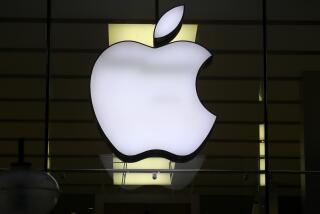Apple Rolls Out Cheaper Macintosh Models : Computers: The new PCs are key parts of an aggressive corporate push to slow the firm’s declining market share.
- Share via
FREMONT, Calif. — Apple Computer Inc., in an aggressive but overdue effort to stem a decline in market share, launched a new line of computers Monday that cuts the price of the flagship Macintosh in half and fundamentally alters the company’s strategy.
The elaborate introduction ceremony, featuring live satellite links with Berlin, Singapore and a number of U.S. locations, took place at Apple’s factory in Fremont, emphasizing the company’s intention to transform itself into a high-volume, low-cost manufacturer of personal computers.
The new strategy has been described by Apple Chairman and Chief Executive John A. Sculley as the outgrowth of a complete re-evaluation of how Apple will compete in the volatile personal computer business. Although the Macintosh is widely recognized as being easier to use than competing IBM-compatible personal computers, it has also been far more expensive--until now.
Analysts say Cupertino, Calif.-based Apple must increase its market share beyond the estimated 10% that it now holds if it is to be more than a niche player in a market dominated by IBM-compatible machines that use the DOS operating system. That challenge has been sharpened by the success of Microsoft’s Windows 3 software, which gives DOS machines many of the easy-to-use features that made the Macintosh a success.
Most analysts have praised the new products, whose basic characteristics have been widely known for months, although Wall Street has been uncomfortable with the expected reduction in Apple’s profit margins that will come with the low-priced products.
“This is a tremendous product announcement, though I don’t know why they didn’t do it a year ago,” said David Wu, a computer analyst with S. G. Warburg & Co.
Sculley emphasized that Apple did not simply cut prices of existing machines, but rather redesigned them to reduce cost and increase performance. And though he said the economy was already in a recession, he nonetheless maintained that businesses and consumers would continue to buy productivity-enhancing computers.
The new Apple machines include:
* The Macintosh Classic, an entry-level computer priced at $999 with one megabyte of memory and a floppy-disk drive, or $1,499 with two megabytes of memory and a 40-megabyte hard-disk drive. The Classic, available immediately, is equivalent to the Macintosh SE, which will be discontinued, as will the Macintosh Plus.
* The Macintosh LC, a color computer that has a small, pizza-box-like shape with a separate monitor. It comes with a 40-megabyte hard-disk drive and a new sound-editing system that allows voice or other sound to be attached to files and edited. The LC, which will not be available in volume until February, will sell for $2,499 without a monitor. A special card that will allow the machine to run Apple II software will cost $199.
* The Macintosh IIsi, a high-performance color machine that uses the fast 68030 microprocessor from Motorola. The IIsi is faster and has better expansion capabilities than the LC, and includes the new sound-editing system. It is also available now, at a price of $3,769 in a basic configuration that includes two megabytes of memory and a 40-megabyte hard disk. It replaces the existing Mac IIcx.
All the products are expected to sell at “street prices” up to 20% below the listed price.
Sculley said the new machines had been brought to market even more quickly than Apple had originally planned, and that the company would have plenty of the Macintosh Classics on hand for the Christmas season. But the limited availability of the LC, considered by some analysts the most important of the new products, could make it harder for Apple to build momentum.
The LC is the key to Apple’s efforts to win back the education market, which it once dominated with the Apple II but has lately lost to IBM-compatible machines. One of the new television advertisements that are part of a $40-million marketing campaign features a teacher giving a roomful of LC-equipped students an inspirational lecture on the value of production and productivity.






